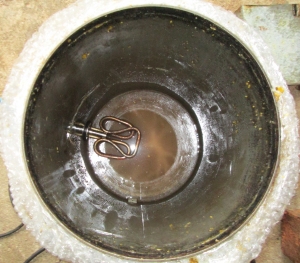
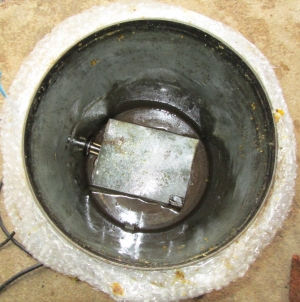
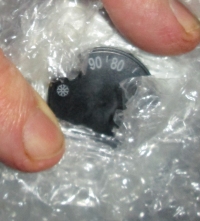
Extracting beeswax from combs with a thermostatically controlled boiler
After getting some rather dark waxes from old, black, cocoon-rich combs using a solar extractor, I decided to have another go at rendering combs by the boiler method. I already had a home-made boiler for cleaning frames. It just needed a thermostat adding.
The boiler comprises a 5-gallon (25 litre) mineral oil can with a 3 kW electric kettle element in the bottom, and a strap-on hot-water cylinder thermostat tied about two thirds of the way up the side. It is wrapped in an insulating jacket made of several layers of bubble-wrap. The element has a metal cover over it to prevent the bag of combs from resting on the element.1
Left: element Centre: element cover Right: Thermostat control buried in insulation



Some internet pages advise against using steel in contact with the wax and mixture, but no obvious sign of reduced wax quality has been observed. The oil can probably has a internal coating of some sort, possibly tin.
The combs are placed in a closed bag made of mutton cloth (stockinette), a tubular knitted cotton fabric. The bag may be closed by tying each end with string or, for convenience, with a releasable cable tie. To ease packing the combs into the bag, it is pegged in place in a 5-gallon plastic bucket of the same diameter as the boiler. This arrangement takes 10 Warré combs, 9 in a row and one more split in two lengthways at each side of the others. These, being combs still coated with honey, some containing pollen, weighed about 4 kg. Several extractions were made with pressed comb, in which case up to 7 kg of comb could be fitted in the bag each time.
Left: packing the combs in the mutton cloth bag Right: releasable cable tie as bag closure
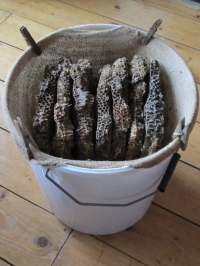
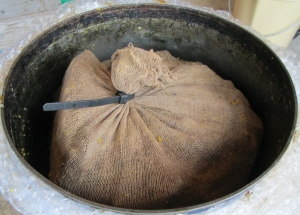
First efforts with this method some years ago hit the snag of weighting down the bag. As its contents disintegrated parts of the bag rose to the surface. This problem was overcome in the present setup by making a weight support cylinder which fitted fairly tightly into the boiler and had a sufficient depth (150 mm) so that it could not tilt, whatever happened in the bag. The cylinder is fixed to a disc perforated with 12.5 mm holes to allow the melted wax to rise to the surface. The disc in this case is the bottom of a 5-gallon plastic bucket. The same functionality would have been achieved by using the bottom 150 mm of such a bucket, even though such buckets have a slight taper.
Left: weight support cylinder Right: weight support cylinder with weight (stone) in position
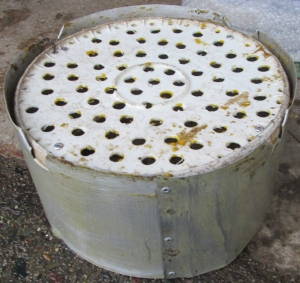
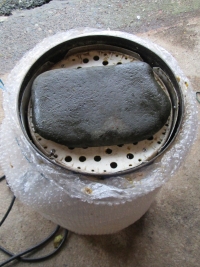
Some authors advise against using tap water, saying that it affects the quality of the wax. Water in my locality is very soft and can be used for this purpose without any obvious problems. However, most of the first dozen or so extractions were done with rain water collected from a shed roof. It had to be filtered as there were bits in it. Water was added until the level was 25 mm below the rim of the boiler. An insulating cover comprising two 20 mm thick sheets of foam polythene was fitted, followed by a board and a half brick. The thermostat was set at about 80 degrees Celsius and the power was turned on.
Left: filtering rainwater into the boiler Right: insulating cover on boiler
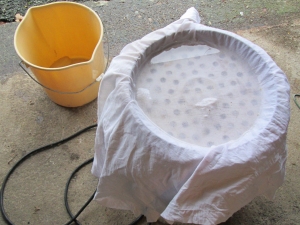
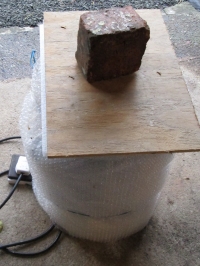
An extraction was generally started in the morning and left to progress all day until late evening -- approximately 9 hours total. From time to time, the bag was prodded with a blunt dowel in various places through the holes in the weight support. This released trapped air and wax. The weight on its support was pushed down further into the boiler as the combs disintegrated, thus leaving an uncluttered zone of water at the surface where the released wax could accumulate. As the level of the water fell due to the bubbles of air released, it was topped-up with tap water. At the end of the extraction, the power was disconnected and the cover removed to allow the liquid wax to set. The resulting slightly domed wax cake was removed the following morning. It had shrunk away from the can's walls. Cakes had clean wax inside but dark deposits on their outsides. These were due to fragments of comb, propolis and pollen passing through the relatively coarse weave of the mutton cloth.
Left: wax cake after cooling Right: a cake 35 mm thick, showing it is light coloured on the inside but dirty on the outside.
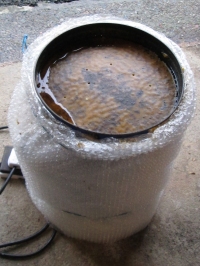
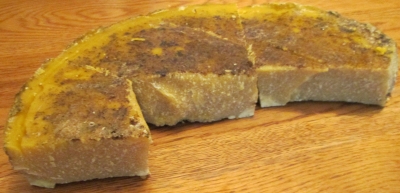
The yield varied greatly. The resulting 270 mm wide wax cakes weighed 0.30-1.86 kg with thicknesses from 10 to 35 mm respectively. The great range was partly due to the weight of comb fitted into the bag and its age, dark, cocoon-rich combs yielding the least amount of wax.
The power consumption was monitored with an electricity meter. It was less than 3 kWh per extraction.
As, unlike with the solar extractor that has its own internal hot filtration feature, the wax rendered in this way was contaminated with particulates. Therefore it had to be hot filtered. A 5-litre can with the top cut off was used for this. The filter comprised a piece of old cotton sheet, pegged to the rim of the can all round and hanging about 150 mm into the can. Chunks of wax were placed in the filter and the can put in an electric oven set at 70 degrees Celsius.2 Every few hours, melted was poured from the can into a tray fitted with plastic film (rubbish bag). The mould was intentionally wide so as to make thin slabs of wax that could easily be broken into small pieces and would melt quickly in the candle dipping apparatus. The wax slabs were up to 10 mm thick.
Left: wax filtration can in oven Centre: set wax slab in tray Right: used filter
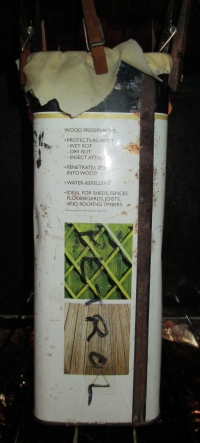
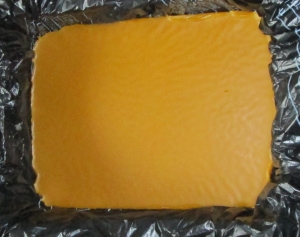
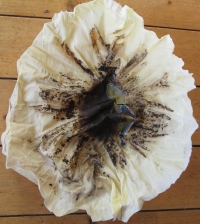
Resulting slabs of yellow wax.
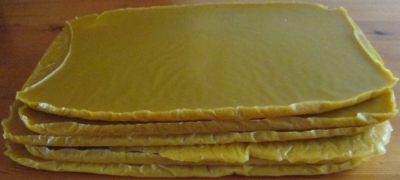
Notes
1. The kettle element can sometimes be acquired secondhand. Otherwise both element and thermostat can be purcased on Ebay for around £20 (US$28)
2. As an oven thermostat can fail, it is advisable not to leave it unattended or with power on on all night.